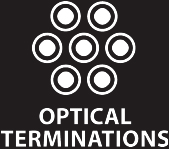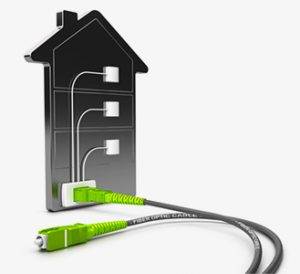
There are 2 types of asset in an FTTP network. These are the passive components (cable, cabinets etc) and the Active components (such as the transmitters and receivers. In this article we will outline the key passive components you will need to install in your FTTP network. In the next article, we will describe the active components.
FTTP runs a design system called GPON (Gigabit Passive Optical Network). The essence is that each apartment is serviced by a dedicated fibre optic cable. This cable then terminates in the main equipment room for the complex (MDF), where the active equipment is located, and also where the incoming Carrier cable terminates.
The main passive elements of a GPON are cable, termination boxes, connectors and splitters.
MDF Room Rack
All equipment is mounted in the MDF room (Man Distribution Frame room) in the basement. There is a rack for the passive cabling and a rack for the Active equipment. The Passive equipment rack holds the Fibre Breakout Trays (FOBOTs) and the rack mounted splitters.
Optical Splitters
One of the first decisions to make is what type of split solution your system will run. There are 2 main types of solution: centralised splitting and distributed splitting.
Centralised splitting is the most common design, where all splitters are housed in the main communications Cabinet in the comms room or MDF room. A very common sized splitter is a 1RU rack mountable splitter with a ration of 1:32. This means that every service emanating from the OLT (Optical Line Terminal) can be split and will service up to 32 apartments. The OLT is in turn fed by the backhaul service. If this needs to be increased over time because more customers are accessing more content, then this can be done by the Telco running the FTTP network.
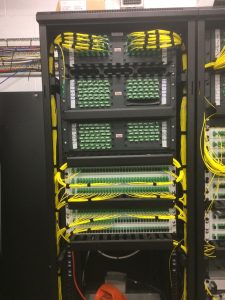
MDF rack showing termination FOBTs and splitters in grey.
Backbone cable and IDF breakout boxes
All GPON networks run on singlemode cables. Most systems require a one-for-one fibre per apartment downstream of the optical splitter. In a typical example of a 200 apartment complex, each residential tower will be fed by a ‘trunk’ cable, usually up to 144 cores. These will then be progressively routed to aggregation points where 12 or 24 units are serviced from an Intermediate Distribution Frame (IDF).
An example of an IDF breakout box is the Tyco BUDI box below. The backbone cable enters and exits the enclosure on the left allowing the specific fibres to be spliced through to the unit cables, which enter on the right.
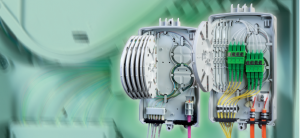 Tyco BUDI enclosure.
Tyco BUDI enclosure.
Apartment Cables
Each apartment is then cabled individually from the IDF to the communications hub in the apartment, usually in a closet or a kitchen cupboard. This cable can be either a pre-made lead or raw cable that is terminated after installation. Pre-made leads offer speed and quality advantages, but you need to have accurate lengths prior to installation.
Apartment Comms Hub
Each apartment should have a dedicated area set aside for the incoming fibre and the cabling running to the internal data & TV points in the unit. The Network Termination Device (NTD) and any wi-fi modems will also be kept here. This is usually in either a kitchen cupboard or in a bedroom closet. It is important that the communications hub allows for the cables and modems to be protected. The area must also be dry, so the laundry or bathroom are inappropriate areas for the communications hub.
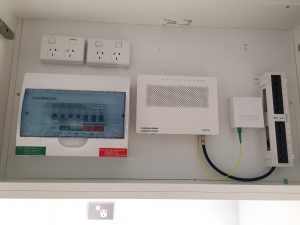
Photo showing apartment hub.
Connectors on the cable
Most FTTP systems require connectors with angled end faces, either SC Angled or LC Angled. (These connectors are green for easy identification). This minimises back reflections, which is especially important for TV signal quality. As long as this is established at the time of design, there will be no issues at installation.
How can Optical Terminations Help?
We’ve been at the forefront of the FTTP market since 2011. We are state finalists in the NECA Excellence Awards (2014) for our FTTP design and implementation. We are able to bring that excellence to assist you in the design of your FTTP network.
For advice on how you can gain the advantages of FTTP in your next development, feel free to call Optical Terminations on 1300 750 558 or click here to download our latest report “How to unlock an extra $2m Profit from your 100 unit development”.


